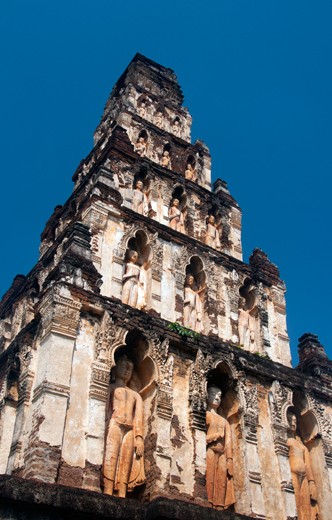Features on Asian Art, Culture, History & Travel
Features
Features > Languid Lamphun

Languid Lamphun
Exploring Northern Thailand’s Oldest City
SEE RELATED IMAGES @ PICTURES FROM HISTORY
The quiet, provincial town of Lamphun just 26 kilometres south of Chiang Mai, is generally promoted as an enjoyable side trip from the northern capital. A combination of tranquil, lotus-filled moats, some of the most distinguished religious buildings in Thailand, and the story of Queen Chamadevi, combine to attract Thai and overseas visitors alike.
Unusually for modern times, one of the great pleasures of a visit to Lamphun is the actual journey from Chiang Mai. The traveller should head south along the old road – Highway 106 – avoiding the new super highway. This road, which once connected the northern capital's Chiang Mai Gate with Lamphun's North Gate, is steeped in history. From the Chiang Mai suburb of Nong Hoi south, for a distance of 12 kilometres, the road is lined by lofty 30-metre high yang trees, interspersed with fruit orchards.
En route the road passes through the quiet village of Saraphi, renowned for its basketry and bamboo furniture products. Several shops selling these goods at very competitive prices stand beside the tree-lined road. Between the yang trees and fruit orchards stand frequent signs for garden restaurants – quiet, rural venues, set back off the road and much appreciated by the people of Chiang Mai and Lamphun alike.
At the peak of its power and influence, Lamphun was better known as the capital of the Kingdom of Haripunchai. Founded by Buddhist monks from Lopburi, under the legendary Queen Chamadevi, Haripunchai flourished as a centre of Mon culture and influence until its eventual absorption by King Mangrai of Lanna, in 1281 – long after the demise of the more southerly Mon Kingdom of Dvaravati.
Today the chief relics of Chamadevi which grace Lamphun include the revered Wat Phra That Haripunchai and – of course – Wat Chamadevi, also known locally as Wat Ku Kut. Both structures, although restored many times, show clear evidence of Mon-Dvaravati style, and must rank amongst the most important cultural treasures of North Thailand.
Wat Phra That Haripunchai. This magnificent temple, unequalled in north Thailand except, perhaps, by Wat Phra That Lampang Luang, was founded in 1044 by King Athitayaraj of Haripunchai on the site of Chamadevi's royal palace. Legend has it that the queen's personal quarters are enclosed in the main 46-metre high Lanna-style chedi, covered in copper plates and topped by a gold umbrella.
Even so, at least one more Lamphun temple is essential viewing, and in its own way it is as important as Wat Phra That Haripunchai. This is Wat Chamadevi, better known locally as Wat Ku Kut. Named after Lamphun's founder and most famous ruler, this temple lies on the western side of town, about one-and-a-half kilometres from the moats down the road to Sanpathong Village.
Wat Chamadevi is the site of the two oldest surviving monuments in Lamphun, both brick chedis decorated with stucco figures of the Buddha, dating from 1218, and considered to be the finest surviving examples of Haripunchai – indeed, Mon – architecture in Thailand. The larger of the two, Chedi Suwan Chang Kot, is a stepped pyramid 21 metres high, thought to have been modelled on a similar dagoba in Polonnaruwa, Sri Lanka. Nearby there is another chedi of smaller proportions but equal style. This structure, the Ratana Chedi, is rumoured to contain the ashes of Queen Chamadevi herself.
At the southern end of Inthayongyot Road, near the banks of the encircling moat, may be seen the striking statue of Queen Chamadevi. This remarkable ruler, who was instrumental in the spread of Buddhism and of Mon culture in the region more than one thousand years ago, is one of the heroines of Thai history. By all accounts she was both determined and ingenious, so it comes as no surprise that to this day the women of Lamphun are considered strong-willed and proud because of her influence!
Later, when her legendary elephant "Blacky-Purple" died, Chamadevi buried it with great honour beneath a monument which still stands near Lamphun railway station. Here, too, can be seen monuments to Chamadevi's favourite horse and to her cockerel "which crowed so loud and shrill that it was clearly audible as far as Lopburi."
SEE RELATED IMAGES @ PICTURES FROM HISTORY
Text by Andrew Forbes; Photos by David Henley & Pictures From History - © CPA Media
